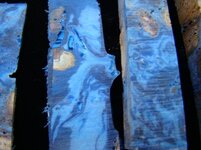td
Banned
I've been having WAY to much fun with Pearl Ex pigments. The thing is, I usually use the pigments with some opaque dye. (I prefer the Mixol pastes, then the Casting Craft dyes.) Enter a customer who wants opaque bold college colors of Blue and Gold without the "shimmer". When I cast the Casting Craft PR with no pigment, only dyes, the colors didn't "swirl" they mixed to make a blue-green mush. Has anybody worked with the Interference colors that Pearl Ex makes? There are two shades in the Series 1 pack.
Otherwise, any tips on bold opaque non-bleeding color casts?
Otherwise, any tips on bold opaque non-bleeding color casts?

